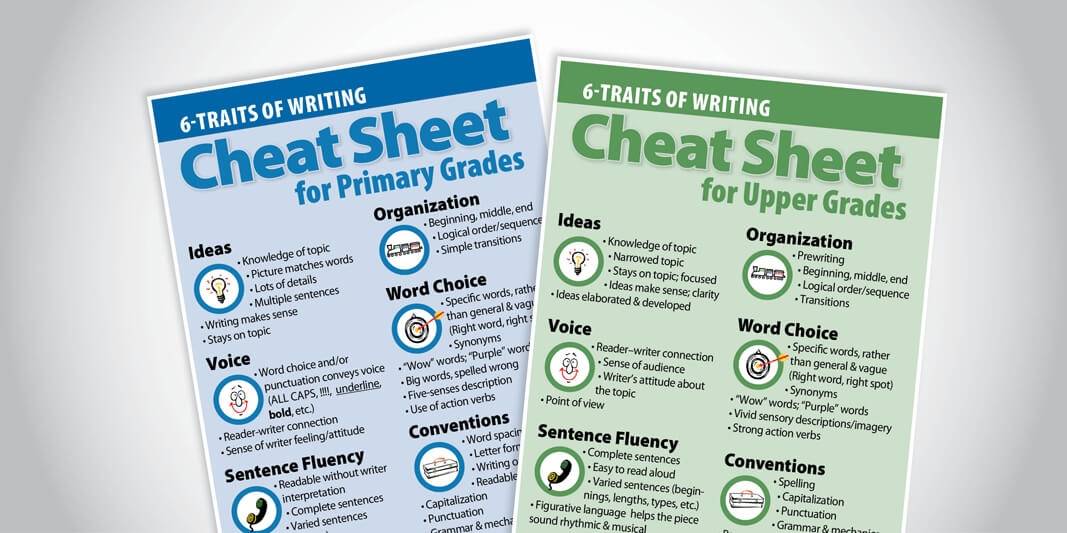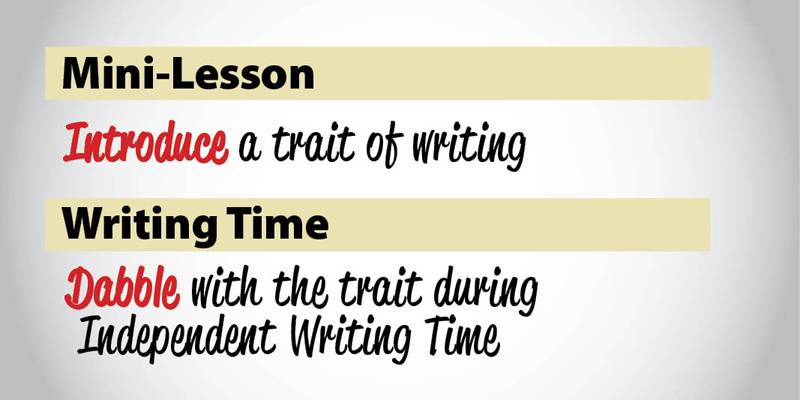writing
Introduce “good” writing by defining the 6 Traits

If you spend some time in the early weeks of school describing what “good” writing includes, then you can curb the number of times you hear Is this good? Am I done? Is this what you want?? from your students.
“Good” writing ingredients
The six researched components of all good writing (ideas, organization, voice, word choice, sentence fluency, and conventions) need to be introduced to students in a kid-friendly way. Don’t be the only one in the classroom who knows what a “good” one is. Share the 6 Traits of Writing with your students.
Plan your trait introduction
Consider setting aside 1-2 writing mini-lessons per trait–that’s 6-12 days total. Within these initial lessons, introduce the six terms quickly. Remember this is only an introduction meant to build common vocabulary between you and your students.
Consistent approach
Not only do you want to consider the pacing of your introduction, but also the common thread. Introduce all the traits in a consistent manner. For example, read picture books for all or sing songs for all or do an activity for all, etc. The consistency will show students how the traits all work together; they are all ingredients of a “good” one.
Visual display
Incorporate the 6 Traits of Writing into your physical classroom environment by starting a yearlong bulletin board during the initial trait introduction.
Graphic icons
When thinking of how to introduce the traits to your writers, consider incorporating a consistent set of visual icons that represent each trait. Not only do students hear the same trait words from year to year, but they see the same graphics. This begins to develop building-wide consistency in implementation and writing expectations.

The icons appearing here are ones Kristina Smekens selected to correspond with each trait. You can also click here to read a rationale for choosing each icon. If you like these icons, you may download them here for free.
- Access the 6-Traits 8.5 x 11 Mini-Posters PDF version.
- Access the 6-Trait icons in a Word document.
- Download a zip-file of the 6-Traits JPEGs.
- Purchase a 6-Traits poster from The Literacy Store to display the traits.
Great Teacher Questions:
Suzanna Wilson asked:
I am taking a graduate course and want to focus my class project on the Six-Traits writing model. I can’t seem to find the research behind the model. Can you help me?
Kristina answered:
The research on 6 Traits is being conducted at the Northwest Regional Laboratory (NWREL) in Oregon. Here is a link to their site and the research they have published.
Nicole Harned asked:
What are some rigorous questions that I can ask my fourth-grade students during my mini-lesson on all the traits? I am being asked to write them in my lesson plans. This week I am expected to do all 6 traits in one week. I do plan on going back and teaching all of them again though.
Kristina answered:
Remembering that the students are just being introduced to the traits during this week, your “rigorous questions” need to be appropriate for their limited trait knowledge. Rather than asking questions about the trait as a writer, consider coming at this from a reader’s standpoint. After reading a strong example/anchor/excerpt of that trait, ask students about the trait’s impact on them as a reader/listener.
- IDEAS: What is the most important information you heard as a reader? Which small detail(s) are most memorable? Do you think the author included those on purpose? What if he’d left those out of his writing, would that make a difference on what you heard/learned?
- ORGANIZATION: Let’s look at how the writer organized these ideas. I’m wondering if you would have liked this piece as much if the writer didn’t present the details/information in this order. Do you think he did this on purpose? What if he’d organized his ideas differently, would that make a difference on what you heard/learned?
- VOICE: Can you tell how the writer feels about this topic/situation? Do you think he did this on purpose? Does hearing the author’s voice make a difference for you as a reader?
- WORD CHOICE: Which words paint a picture in your mind as a reader? Do you think he chose (this word/phrase) on purpose? What if he used a different word/synonym; would that change your understanding?
- SENTENCE FLUENCY: Let’s look at the different sentence types/lengths in this part of the writing. What if they author hadn’t written such short and long sentences, but made them all about the same length? Would that change your engagement level as a reader? Did you think varying sentence lengths was really that big of a deal?
- CONVENTIONS: (Choose a text where the punctuation marks are varied and play an important role in reading the piece with accurate expression.) Did you notice how I read that text? Did you hear how my voice got quiet here and loud here and slower here? I did that because of the conventions/punctuation the author used. What if he didn’t use this mark, but instead used a different one? Would it change how this sounds and what it means? Do you think he chose that punctuation on purpose?
When your introduction of the 6 Traits focuses on the impact they can have on a reader, then students see the power of learning more about them. They realize they want to have the same control, power, and impact on their own audiences.
Great Teacher Comments:
Here’s a great 6-Traits idea that came from a hallway bulletin board on display at Washington Township Elementary (East Porter County Schools, Kouts, IN). When students had completed a writing, they each read their pieces to classmates. The peers listened and identified the strongest trait in each one. Then, when it came time to display their work in the hallway, they grouped them according to the traits of strength. What a great idea!
 Ready to learn more about the 6 Traits?
Ready to learn more about the 6 Traits?
Enroll in a Smekens workshop on the 6 Traits of Writing to unlock the power of the Traits for your writing instruction.

Ready to learn more about the 6 Traits?
Enroll in a Smekens workshop on the 6 Traits of Writing to unlock the power of the Traits for your writing instruction.





